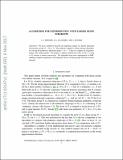Algorithms for experimenting with Zariski dense subgroups
Abstract
We give a method to describe all congruence images of a finitely generated Zariski dense group H ≤ SL (n,ℤ). The method is applied to obtain efficient algorithms for solving this problem in odd prime degree n;if n=2 then we compute all congruence images only modulo primes. We propose a separate method that works for all n as long as H contains a known transvection. The algorithms have been implemented in GAP, enabling computer experiments with important classes of linear groups that have recently emerged.
Citation
Detinko , A , Flannery , D & Hulpke , A 2018 , ' Algorithms for experimenting with Zariski dense subgroups ' , Experimental Mathematics , vol. Latest Articles . https://doi.org/10.1080/10586458.2018.1466217
Publication
Experimental Mathematics
Status
Peer reviewed
ISSN
1058-6458Type
Journal article
Description
Our work was supported by a Marie Skłodowska-Curie Individual Fellowship grant under Horizon 2020 (EU Framework Programme for Research and Innovation), and Simons Foundation Collaboration Grant 244502.Collections
Items in the St Andrews Research Repository are protected by copyright, with all rights reserved, unless otherwise indicated.

